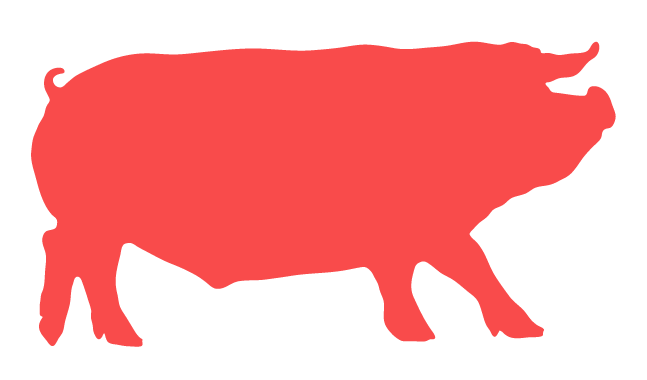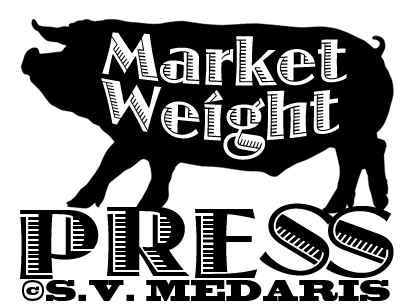 So, I’ve been wanting to do a big woodcut for some time. At the Frogman’s workshop this summer, we cut on birch plywood−first time for me, so I thought (when buying the 4’x8′ sheet once home), “why not use the whole sheet?.” So I cut a 4×8 hog−the model being one of my full-grown feeder pigs. And how great would it be to do a big pulltoy with this big print on one side? It would be perfect for a piece for our 3rd-year grad student show. So, here’s the progression (click any image to see it larger):
So, I’ve been wanting to do a big woodcut for some time. At the Frogman’s workshop this summer, we cut on birch plywood−first time for me, so I thought (when buying the 4’x8′ sheet once home), “why not use the whole sheet?.” So I cut a 4×8 hog−the model being one of my full-grown feeder pigs. And how great would it be to do a big pulltoy with this big print on one side? It would be perfect for a piece for our 3rd-year grad student show. So, here’s the progression (click any image to see it larger):
1.) Carving the woodblock: a 4ft x 8ft sheet of birch plywood. Here, I’m cutting with a reciprocating carver (as opposed to a rotary−it moves back and forth−it’s an electric gauge). Definitely saved my hands, wrists and forearms…. Almost no pain cutting the entire block, with alternating between the reciprocating carver and the hand-tool gouges:

2.) And here’s the cutout shape upon which the print would go. I was going to use a jigsaw, but J says: “No, you have to use a Rotozip.” “But how do you know? The wood girl said use a jigsaw and she’s a woodworker!” I stupidly asked/retorted. Argument ensued. J went and got the Rotozip out and showed me. He was right. It rocked!! And more, I could cut it out myself and do an ok job. Super (pretty super) fast. Zip-a-Dee-Doo-Dah! Cut out 2 shapes out of OSB, screwed in 2×4’s in-between the 2 (to give it some depth), then cardboard was stapled all around the edge of the whole shape (to enclose it, make it look as if it was a thick, solid wooden cutout−like the little wooden pulltoys). Here’s the cutout, with Zuzu for scale:
3.) Here’s the finished, 4x8ft woodcut block (broom for scale):

4.) Once block carving is finished, it’s time to print. I have an awesome Takach roller, which helps immensely (a good quality, large roller), although I gotta say, inking the damn thing was a pain. Think about it (I didn’t, really, beforehand), you have to roll over the whole 4ft x 8ft sheet, without actually stepping on it/in the ink, meanwhile getting a consistent layer of ink over the whole thing. All I can say is that it’s a good thing I’m tall with long arms, and that I didn’t thoroughly think this through ahead of time (I don’t tend to trully consider the potential problems of a thing until I’m in it, which I think is my way of not talking myself out of something−I vaguely consider/imagine how it’ll happen and just mentally “ok” the process). Oh, and the paper. I couldn’t find any 4ft wide paper in a roll, so in keeping with my previous collaged work, I printed on feed sacks−not really the ideal printing surface. But the thing I loved about the final print was that the feedsacks showed through the overlaying hog print. Here are the printed sections on feedsack sections (top) and practice prints on big sheets of tracing paper below that:
5.) Pulltoy shape is sealed somewhat with white paint/Kilz, and pull-rope prepared (J, the knot expert did that beautiful woven loop at end), getting ready for the prints to be applied:

6.) Gluing the feedsack prints to the cutout shape with acrylic medium:

7.) Printed side finished! Rope aged (dipped in bucket of water, black ink, acrylic paint), and attached with chain and hook eyes. Wheeled the thing out to the road, with little dogs pattering beside me and then posing. Such good little terriers:

"Market Weight Pull-Toy" • woodcut prints and paint on feedsacks; wood, cardboard, training wheels, rope (hog side)
8.) On the other side, I wanted to do the cuts of the hog, when butchering–I love making things educational. I didn’t have time to cut the blocks and print all the words, so I painted in a graphic style (as if it was printed) with somewhat-transparent acrylics, again on top of feedsacks:

"Market Weight Pull-Toy" • woodcut prints and paint on feedsacks; wood, cardboard, training wheels, rope (pork-cuts side)
You can see this piece for a few days still, at our 3rd-year graduate student show: Triple Crown at the UW Art Lofts in Madison, WI.








Thanks Cynde! Power tools are pretty awesome!!
Wow, Sue! You amaze me with your ability to produce imagery within such a wide scale range. Bravo! I’m glad there are tools available to make such an effort less physically taxing.
Thanks Jayne! Yes, you can see the detail still–but definitely not as sharp as the print on tracing paper. If you click on the photo with print just going on the white form (#6) and the photo showing the finished image(#7), the images open in new window, bigger, and you can see better how they look.
Sue,
love the detail and the use of shadow and light on the woodcut image of the hog (images 3 and 4) Hope that showed through on the final with the feedsacks. Hard to tell from the images here.